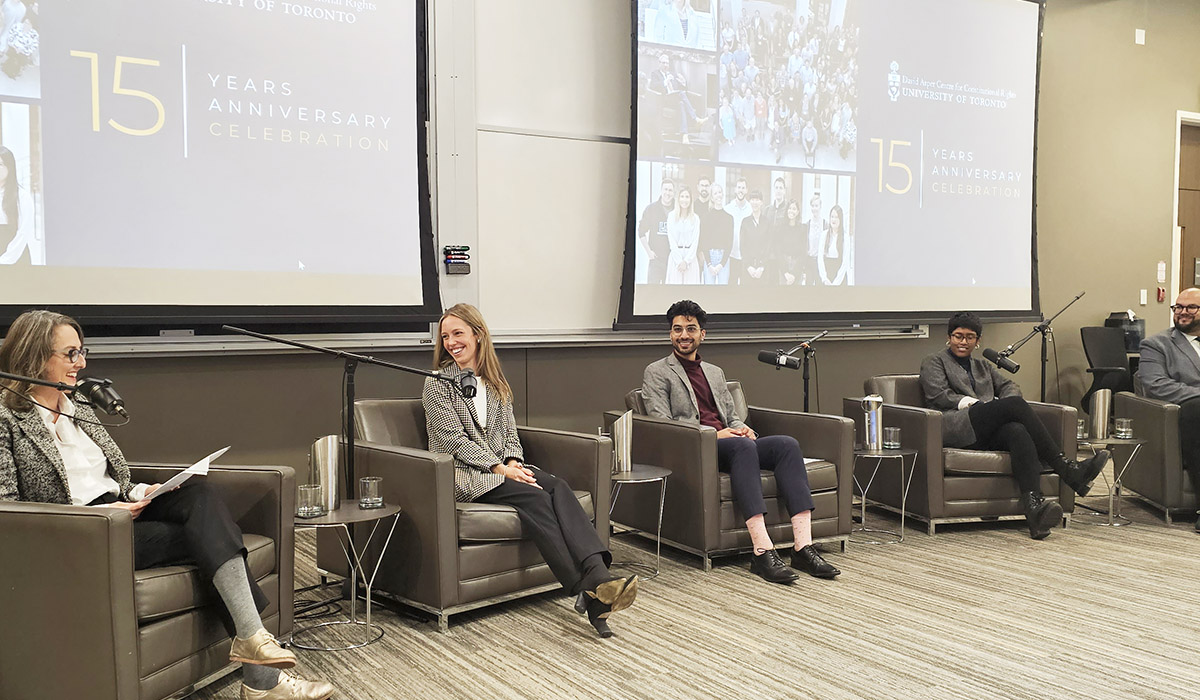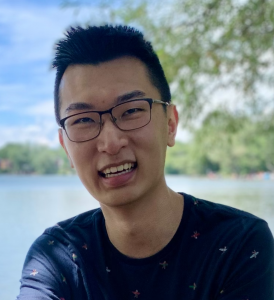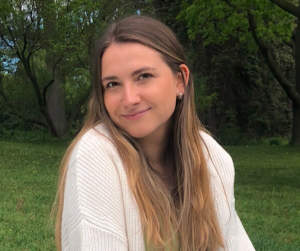by Chelsea Gordon, Daniel Kiesman and Sang Park
On January 15, 2024, the Asper Centre intervened before the Ontario Court of Appeal in Mathur v Ontario. The Asper Centre’s Constitutional Litigator in Residence Ewa Krajewska acted as counsel for the Asper Centre in this intervention. As students in the Asper Centre Clinic course this past term, we had the opportunity to contribute to the intervention by conducting research and drafting versions of the factum as part of our clinic coursework.
Mathur is a significant case because it is the first time that substantive legal issues of a constitutional challenge to insufficient government action to address climate change has been before an appellate court in Canada. Furthermore, this case is also one of the first s. 15(1) Charter cases to reach an appellate court since the Supreme Court modified its approach to s. 15(1) in R v Sharma.[1]
Background
The appellants are a group of seven young Ontarians. The appellants challenge a 2018 decision by the Government of Ontario to lower the province’s greenhouse gas emissions target to 30% below 2005 levels by 2030. Ontario set this target despite scientific research showing that to prevent serious adverse consequences in relation to health, food security, and human security, greenhouse gas emissions would need to be reduced by 52% below 2005 levels by 2030. As a result, the appellants argue that this emissions target violates s. 7 of the Charter by allowing a level of emissions that will lead to serious adverse consequences and put the lives of Ontarians at risk. The appellants also argue that the emissions target violates s. 15(1) of the Charter because young people and future generations will disproportionately bear the burdens and face the adverse effects of inadequate climate change policy.
The Superior Court of Ontario held that the appellants’ challenge was justiciable but dismissed the appellants’ Charter claims.[2] The Asper Centre also intervened at the Superior Court, read the factum here.
With regard to s. 7 the application judge appeared open to the idea that climate change could be the kind of issue area where a positive s. 7 obligation on government could arise and assumed without deciding that a positive obligation arose here.[3] However, the application judge held that the emissions target did not infringe any principles of fundamental justice and therefore did not infringe s. 7.[4] Regarding s. 15(1) the application judge, applying Sharma, held that the claim must fail at the first step of the test as causation cannot be established. The application judge held that causation could not be established because the “disproportionate impact is caused by climate change and not the [emissions] target.”[5]
The Asper Centre’s Intervention at the Court of Appeal
The Asper Centre’s intervention at the Court of Appeal is focused on two issues. First, that the application judge erred by adopting a formalistic approach to causation that has consistently been rejected by the s. 15(1) jurisprudence. Second, given the complexities and the novelty of climate change, should the Court of Appeal find a Charter infringement it ought to go beyond declaratory relief to craft an appropriate and just remedy under s. 24(1) of the Charter.
Read the Asper Centre’s factum here.
In its submissions relating to causation in the s. 15(1) analysis, the Asper Centre traces the history of equality jurisprudence to underscore that substantive equality drives the s. 15(1) analysis and that the application judge erred by abandoning a substantive approach and adopting a formalistic analysis of causation. The Asper Centre notes that from the start, in the first s. 15(1) case Andrews v Law Society of British Columbia, the Supreme Court recognized that a seemingly neutral law may create an unequal impact on a particular group and as a result the s. 15(1) analysis must focus on the impact of the law on a particular group.[6] This approach has been repeatedly affirmed in subsequent Supreme Court decisions. Most recently the importance of substantive equality was reaffirmed in Sharma where the Supreme Court stated it is an “animating norm” of s. 15(1).
Furthermore, the intervention seeks to emphasize that the proper approach to causation must be flexible and contextual. Such an approach does not require that an impugned law be the only cause of an adverse impact. Rather, to establish causation a claimant need only show that a law is a cause. To support this approach the Asper Centre highlights cases such as Fraser v Canada (Attorney General) where an RCMP job-sharing program, which was not in and of itself the root cause of wage inequality, was found to infringe s. 15(1) because it furthered the economic disadvantages women face in society.[7]
Despite these precedents, the application judge adopted a formal and rigid approach to causation, holding that the emissions target did not infringe s. 15(1) because the harms to youth are caused by climate change. This approach harkens back to the rejected approach to equality taken under the Canadian Bill of Rights wherein a provision which restricted access to employment insurance to pregnant women was allowed to stand because the discriminatory impact on pregnant women was not caused by the legislation, but by the fact that the women were pregnant. This approach also departs from the decades of precedent which instruct a flexible and contextual approach that centres substantive equality at the heart of s. 15(1).
Should the Court of Appeal find a Charter infringement the Asper Centre’s submission encourages the Court to be creative and utilize its remedial discretion under s. 24(1) of the Charter to forge an appropriate and just remedy. Declaratory relief will be insufficient in this case as the impacts of climate change, stemming from government inaction present complex and novel issues for the legal system. Faced with novel issues the Supreme Court, in cases such as Ontario v G[8] and Doucet-Boudreau v Nova Scotia (Minister of Education),[9] has crafted unique remedies under s. 24(1). Furthermore, as the Asper Centre notes in its factum, courts in other jurisdictions, such as the German Constitutional Court[10] and the Supreme Court of the Netherlands,[11] which have confronted the issue of inadequate government climate policies have crafted creative remedies aimed at addressing the complexities of climate change.
Chelsea Gordon, Daniel Kiesman and Sang Park are JD Candidates at the Faculty of Law and were Asper Centre clinic students in Fall 2023.
[1] R v Sharma, 2022 SCC 39.
[2] Mathur v Ontario, 2023 ONSC 2316
[3] Mathur v Ontario, 2023 ONSC 2316 at para 82.
[4] Mathur v Ontario, 2023 ONSC 2316 at para 142.
[5] Mathur v Ontario, 2023 ONSC 2316 at para 178.
[6] Andrews v Law Society of British Columbia, [1989] 1 SCR 143 at 164.
[7] Fraser v Canada (Attorney General), 2020 SCC 28 at paras 92-107, 113.
[8] Ontario (Attorney General) v G, 2020 SCC 38.
[9] Doucet-Boudreau v Nova Scotia (Minister of Education), 2003 SCC 62.
[10] 1 BvR 2656/18 (2021).
[11] C-565/19 P, C/09/456689 / HA ZA 13-1396.






 Szymon will be entering his 3L year at the University of Toronto Faculty of Law. He studied international development, politics and sociology at Trent University. Szymon is laying the groundwork for the Asper Centre’s Podcast Project. He is currently conducting research on constitutional law cases that the Asper Centre and Faculty of Law alumni have been involved in, brainstorming possible topics and case law to discuss in each new episode. Szymon also volunteers with Law in Action Within Schools (LAWS), a education program hosted by the University of Toronto Faculty of Law and Osgoode Hall Law School that provides students from four Toronto-area high schools with a variety of extracurricular opportunities related to law and justice. Szymon is an avid runner and enjoys cooking (although he also enjoys running to visit new restaurants as well!).
Szymon will be entering his 3L year at the University of Toronto Faculty of Law. He studied international development, politics and sociology at Trent University. Szymon is laying the groundwork for the Asper Centre’s Podcast Project. He is currently conducting research on constitutional law cases that the Asper Centre and Faculty of Law alumni have been involved in, brainstorming possible topics and case law to discuss in each new episode. Szymon also volunteers with Law in Action Within Schools (LAWS), a education program hosted by the University of Toronto Faculty of Law and Osgoode Hall Law School that provides students from four Toronto-area high schools with a variety of extracurricular opportunities related to law and justice. Szymon is an avid runner and enjoys cooking (although he also enjoys running to visit new restaurants as well!).


